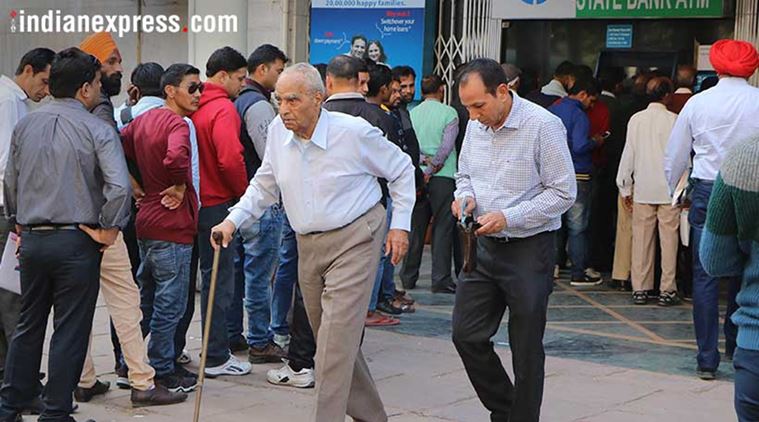Behind shortage of cash, circulation of Rs 200 fast, Rs 2,000 slow: SBI report
The SBI report, which estimates the shortfall at Rs 70,000 crore — a third of the monthly ATM withdrawals — says that declining income velocity indicates that the Rs 2,000 note isn’t getting adequately circulated in the economy.

THE ongoing currency crunch in at least half-a-dozen states could be because of the fast pace of circulation of Rs 200 notes, a sharp slowdown in circulation of Rs 2,000 notes, a rise in currency with the public as a percentage of the currency in circulation and declining “income velocity,” according to a research report from India’s largest bank, State Bank of India.
The income velocity of money is the frequency at which the average same unit of currency is used to purchase new domestically produced goods and services within a given time period. In other words, it is the number of times one unit of money is spent to buy goods and services per unit of time.
The SBI report, which estimates the shortfall at Rs 70,000 crore — a third of the monthly ATM withdrawals — says that declining income velocity indicates that the Rs 2,000 note isn’t getting adequately circulated in the economy.
“Though the state-wise/ region-wise income velocity is hard to determine, yet our internal estimates suggest that in the states like Bihar, Gujarat and Southern States, the income velocity is far less than the national average. The other states have also started facing issues as there has been a ‘domino effect’ whereby any possible tendency to hoard cash may have spread to other States,” it said.
SBI operates more than half of the over 4,000 currency chests in the country.
“There has been a forced shift in currency composition with more of smaller denomination notes in circulation now, which is positive (Government sources suggest printing of Rs 2000 note being less or stopped). For example, in FY17 when remonetisation was achieved there was no Rs 200 denomination note,” the SBI report said.
However, in FY18 the pace of circulating the Rs-200 note has increased, as has happened with notes of smaller denomination. This may have altered the demand for smaller denomination notes in a larger way to possibly substitute for the currency of larger denominations. “As ATMs have to be replenished more frequently, it can lead to the conjecture that cash is not available,” it said.
Additionally, heightened economic activity beginning Q4 of FY18 has meant that the demand for working capital cycle has changed for the better resulting in more usage of cash for transactional purposes. “This may have also prompted more withdrawals at the ATM to support the same level of currency demand. This has amplified over time and is known in the supply chain literature as the Bullwhip Effect,” the SBI report said.
According to the report, currency in circulation (CIC) in the economy has surpassed its pre-demonetisation level of Rs 17.98 lakh crore to reach Rs 18.29 lakh crore by March 2018. Meanwhile, currency with the public as percentage of currency in circulation declined significantly (to a low of 75 per cent as on November 25, 1016) during the demonetisation period. However by the end of FY17, it recovered to its previous levels as percentage of currency in circulation.
“Currency with public has now reached around 96 per cent of currency in circulation. This means that cash in hand (cash at ATM etc) with banks has declined,” SBI said.
During FY18, cash in hand with banks peaked to Rs 92,000 crore by September end which has now reduced to Rs 70,000 crore by mid-March 2018, it said.
Further, during FY18, ATM withdrawals increased by 12.2 per cent in the second half compared to the first half. This growth was much higher compared to FY16 or FY15 and even the five-year average (8.2 per cent during FY12 to FY16). Cash withdrawals in the second half are always more than the first half due to many reasons like festival and procurement season that fall in H2 but in FY18 such a large increase is still not self explanatory.
Based on the nominal GDP growth of 10.8 per cent and 9.8 per cent in FY17 and FY18, currency with public would have been Rs 19.4 lakh crore by March 2018. However, currently currency with the public is at Rs 17.5 lakh crore which shows a gap of Rs 1.9 lakh crore.
The increase in digital modes of payment compensates some part of the existing gap. The shift to digital modes could be at least Rs 1.2 lakh crore. “The apparent shortfall thus could be around Rs 70,000 crore or even less,” it said.
On a monthly basis CIC growth has been Rs 45,000 crore, Rs 51,000 crore and Rs 39,000 crore in January 2018, February 2018 and March 2018 respectively, compared to an average of Rs 10,000 crore, Rs 20,000 crore and Rs 20,000 crore respectively in these three months in previous years (except 2017).



 →
→












0 comments:
Post a Comment